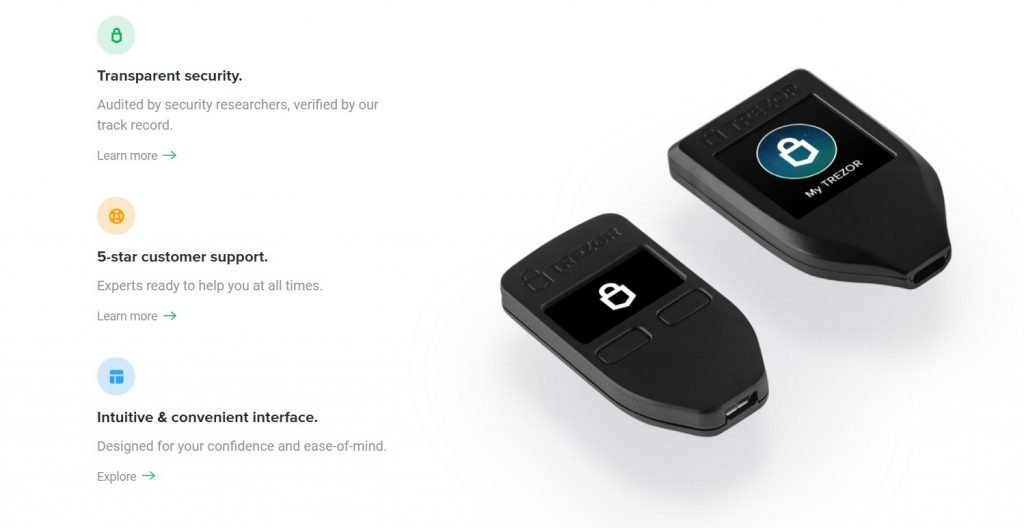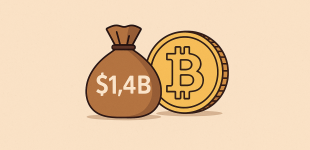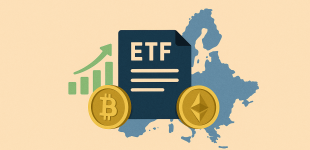Introduction
Trezor is one of the most popular hardware wallet solutions, currently providing two devices, each with unique features. It works as an isolated environment for offline transaction signing and using a small display where users can verify transaction details. Trezor has support for Bitcoin, Litecoin, Dash, Zcash, and more than 1,000 different cryptocurrencies, making it one of the ideal choices for cryptocurrency users wanting to benefit from a wide range of tokens.

The good news about Trezor that the company is audited by security researchers and it provides 5-star customer support. To enable beginners into the world of cryptocurrencies, both hardware wallets come with an intuitive and convenient interface. Thankfully, the Trezor wallets come with a broader set of features, which is why we’ve decided to make a comprehensive review.
Hardware Wallets
Launched in 2014, the Trezor wallet solutions were the first Bitcoin hardware storage options, offering secure cold storage and the ability to spend with the convenience of a hot wallet. Six years later, the features provided by the hardware wallets had improved substantially, with support for more than 1,000 cryptocurrencies and two different products, each with particular features.

Trezor One
Currently priced at €59, Trezor One is the cheapest solution, but with a series of features strong enough to ensure the highest standards promised by a hardware wallet. It comes with support for 1,000 tokens, including Bitcoin, Ether, Dash, Ether, Ethereum Classic, ZCash, and others. Due to affordability reasons, it has a monochrome display and 2 buttons. It’s beginner-friendly and comes with multiple security protections (PIN entry, passphrase entry, device recovery) via computer or mobile. Some of its extra features include a password manager, U2F authentication, encryption via GPG, SSH, and premium support.
Trezor Model T
The second and more expensive wallet version is the Trezor Model T, which comes with some enhanced features. There’s support for all Trezor One coins + Monero, Tezor, Cardano, Ontology, and some other altcoins. It has a full-color touchscreen display and all the security protections are on the Trezor device, not requiring any action from the computer or mobile.
Extra features include Bitcoin-only firmware, Shamir backup, FIDO2 authentication, micro SD card, and others. Due to enhanced features and functionalities, the Trezor Model T price is €180.29. Cryptocurrency users interested to buy either of the wallets, can do that via the official website trezor.io or via one of the resellers and affiliate partners.
Main Features
As one of the most popular hardware wallets, Trezor benefits from a long list of features:
- Support for 1,000 cryptocurrencies, including BTC, ETH, Dash, ZCH, LTC, and others
- Transparent security – audited by security researchers and verified by its track record
- 5-star customer support – Trezor has experts ready to help customers at all times
- Intuitive & convenient interface, designed for your confidence and ease-of-mind
- Recovery seed offline – your entire wallet is always accessible via your personal 12 to 24 words long recovery seed
- Cross-compatible – the recovery seed follows a standard created by SatoshiLabs, compatible with many wallet apps
- Multiple security protection features – PIN entry, passphrase entry, and device recovery
- Extra features – Bitcoin-only firmware, Shamir backup, Password Manager, U2F authentication, FIDO2 authentication, encryption via GPG, SSH, on Trezor data & file protection, and support for microSD card.
- Managing an entire digital identity – coins, keys, and passwords.

Security
Since we’re talking about a hardware wallet, security levels are enhanced as compared to an e-wallet. Since all the data is stored on the Trezor device, someone can’t gain access to it via the internet. At the same time, Trezor has multiple security features in place, to make sure that no vulnerability will ever be exploited.
With security protection via PIN entry, passphrase entry, and device recovery, users will be able to set multiple layers of security. Some extra features like U2F authentication, FIDO2 authentication, encryption via GPG, and SSH Trezor makes sure your cryptocurrencies are always in a safe place.
Pros and Cons
- Trezor has support for more than 1,000 different cryptocurrencies
- Multiple security features to enhance the safety of funds.
- Two hardware wallet solution a cheaper and a premium one.
- Only Trezor Model T owners can benefit from all the features
- Not using a hierarchical deterministic approach
- The wallet is sometimes experiencing attacks through its firmware.
Summary
After being launched more than 6 years ago, Trezor had managed to gain a solid reputation as one of the most reputable hardware wallet solution. Both the Trezor One and the Trezor Model T benefit from good customer reviews, a proof for the good performance. If you are using cryptocurrencies constantly and don’t want to rely on a single hot wallet, a hardware solution like Trezor could be a better option. It’s good to see there a cheaper version available for those who are unable to spend a lot of money on a hardware wallet. Trezor has made a good impression on us.







There are no comments at the moment, do you want to add one?
Write a comment